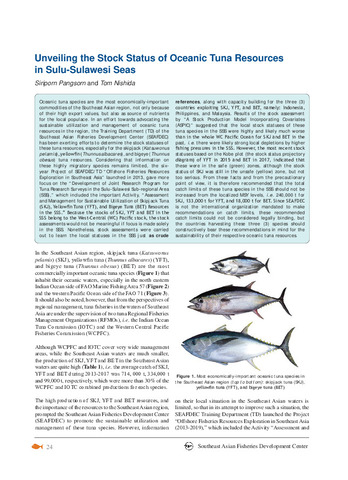| dc.description.abstract | Oceanic tuna species are the most economically-important commodities of the Southeast Asian region, not only because of their high export values, but also as source of nutrients for the local populace. In an effort towards advocating the sustainable utilization and management of oceanic tuna resources in the region, the Training Department (TD) of the Southeast Asian Fisheries Development Center (SEAFDEC) has been exerting efforts to determine the stock statuses of these tuna resources, especially for the skipjack (Katsuwonus pelamis), yellowfin (Thunnus albacares), and bigeye (Thunnus obesus) tuna resources. Considering that information on these highly migratory species remains limited, the sixyear Project of SEAFDEC/TD “Offshore Fisheries Resources Exploration in Southeast Asia” launched in 2013, gave more focus on the “Development of Joint Research Program for Tuna Research Surveys in the Sulu-Sulawesi Sub-regional Area (SSS),” which included the important Activity, “Assessment and Management for Sustainable Utilization of Skipjack Tuna (SKJ), Yellowfin Tuna (YFT), and Bigeye Tuna (BET) Resources in the SSS.” Because the stocks of SKJ, YFT and BET in the SSS belong to the West-Central (WC) Pacific stock, the stock assessments would not be meaningful if focus is made solely in the SSS. Nonetheless, stock assessments were carried out to learn the local statuses in the SSS just as crude references, along with capacity building for the three (3) countries exploiting SKJ, YFT, and BET, namely: Indonesia, Philippines, and Malaysia. Results of the stock assessment by “A Stock Production Model Incorporating Covariates (ASPIC)” suggested that the local stock statuses of these tuna species in the SSS were highly and likely much worse than in the whole WC Pacific Ocean for SKJ and BET in the past, i.e. there were likely strong local depletions by higher fishing pressures in the SSS. However, the most recent stock statuses based on the Kobe plot (the stock status projectory diagram) of YFT in 2015 and BET in 2017, indicated that these were in the safe (green) zones, although the stock status of SKJ was still in the unsafe (yellow) zone, but not too serious. From these facts and from the precautionary point of view, it is therefore recommended that the total catch limits of these tuna species in the SSS should not be increased from the localized MSY levels, i.e. 240,000 t for SKJ, 133,000 t for YFT, and 18,000 t for BET. Since SEAFDEC is not the international organization mandated to make recommendations on catch limits, these recommended catch limits could not be considered legally binding, but the countries harvesting these three (3) species should constructively bear these recommendations in mind for the sustainability of their respective oceanic tuna resources. | en |

